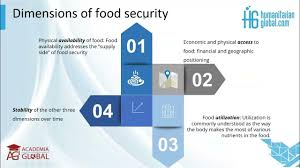Q. Dimensions of Food Security
Understanding food security requires a comprehensive look at
its multifaceted nature. It's far more than simply having enough food; it
encompasses a complex interplay of factors that determine whether individuals
and populations can consistently access and utilize nutritious food for an
active and healthy life. The most widely recognized framework for food security
breaks it down into four key dimensions: availability, access, utilization, and
stability.
- Availability:
- This
dimension focuses on the supply side of food security. It addresses
whether sufficient quantities of food are present within a given area. This
includes food production, stock levels, and trade.
- Factors
influencing availability include:
- Agricultural
production: This is affected by climate, soil quality, water resources,
technology, and farming practices.
- Food
imports and exports: Global trade plays a crucial role in distributing
food resources.
- Food
storage and distribution infrastructure: Efficient systems are necessary
to prevent food loss and ensure timely delivery.
- climate
change: climate change is heavily effecting the availability of food,
through extreme weather events, and changing growing seasons.
- It's
important to note that simply having enough food available at a national
level does not guarantee food security for all individuals.
- Access:
- This
dimension concerns the ability of individuals and households to obtain
sufficient food. It goes beyond physical presence and considers economic
and social factors.
- Key
aspects of access include:
- Economic
access: This refers to the purchasing power of individuals and
households, which is influenced by income, employment, and food prices.
- Physical
access: This involves the ability to reach food sources, which can be
affected by transportation, infrastructure, and geographical location.
- Social
access: This considers social barriers, such as discrimination and
inequality, that can limit access to food for certain groups.
- This
dimension highlights that even with adequate food availability, poverty
and inequality can prevent people from accessing it.
- Utilization:
- This
dimension focuses on how the body uses the food consumed. It addresses
whether food is being properly utilized for good health and nutrition.
- Factors
influencing utilization include:
- Nutritional
quality of food: A balanced diet is essential for optimal health.
- Food
safety: Safe food handling and preparation practices are crucial to
prevent foodborne illnesses.
- Health
and sanitation: Access to clean water, sanitation, and healthcare
services is necessary for the body to effectively utilize nutrients.
- Dietary
practices: cultural norms, and education levels can effect how people
utilize the food that they have access to.
- Utilization
emphasizes that food security is not just about quantity but also about
quality and health.
- Stability:
- This
dimension addresses the consistency of food availability, access, and
utilization over time. It considers the risks and vulnerabilities that
can disrupt food security.
- Key
aspects of stability include:
- Climate
variability and shocks: Droughts, floods, and other extreme weather
events can significantly impact food production and access.
- Economic
shocks: Recessions, inflation, and price volatility can affect
purchasing power and food access.
- Political
instability and conflict: Wars and civil unrest can disrupt food systems
and create food shortages.
- pandemics:
such as the Covid-19 pandemic, can effect all aspects of food security,
through supply chain disruptions, and economic hardship.
- Stability
underscores the importance of resilience and preparedness in ensuring
long-term food security.
In essence, food security is a complex and interconnected
system. Achieving it requires addressing all four dimensions simultaneously. It
involves not only increasing food production but also ensuring equitable
access, promoting healthy diets, and building resilience to shocks and
stresses.








0 comments:
Note: Only a member of this blog may post a comment.